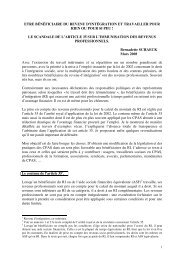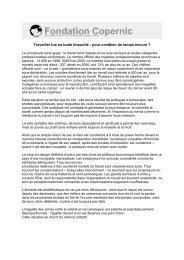Awra Amba RJ 300612 EN - Contacter un comité local d'Attac
Awra Amba RJ 300612 EN - Contacter un comité local d'Attac
Awra Amba RJ 300612 EN - Contacter un comité local d'Attac
Create successful ePaper yourself
Turn your PDF publications into a flip-book with our unique Google optimized e-Paper software.
5. Education<br />
Picture 17: Gathering of children <strong>un</strong>der the authority of an adult in the village centre before going<br />
to school, in April 2010.<br />
In addition the children from <strong>Awra</strong> <strong>Amba</strong> study, in 2010, in the state school four hours a morning on<br />
Saturday and S<strong>un</strong>day for lesson review and exercises. For that the teachers are directly paid by the<br />
comm<strong>un</strong>ity (400 birrs a month, i.e. 22 Euros) (Jo10b/7).<br />
School is free, but materials, notebooks and books will be charged for and are bought by the<br />
comm<strong>un</strong>ity (Crespo, 2011). The <strong>Awra</strong> <strong>Amba</strong> comm<strong>un</strong>ity has better relations with the school than<br />
other comm<strong>un</strong>ities: some of its members have been invited by the school to give a speech on ethics<br />
and other aspects of their experience, but it is not the case of other comm<strong>un</strong>ities (Yi07/88).<br />
The village students are very active in social and ethical clubs of the school, and very comfortable<br />
with the group discussions. They are hard working, preferring to study, or to play and to discuss<br />
between them than to play with others. They consider themselves as members of a same family and<br />
avoid criticizing their comm<strong>un</strong>ity in front of the others. They are not very open to students from<br />
other villages, which for that matter do not appreciate them and avoid mixing with them, especially<br />
during the two first years, because of their assumed lack of religion. However, the relations improve<br />
over time (Yi07/72-79 & 87).<br />
The teachers appreciate the <strong>Awra</strong> <strong>Amba</strong> students, finding them more hardworking, more ethical and<br />
more cooperative than others; they cite them often as an example (Yi07/74-75 et 86). According to<br />
these teachers, they are better than others in first and second grade, because they benefited by<br />
kindergarten, but afterwards they are at the same level (Yi07/72). On the contrary, the head master<br />
had assured us that the students from <strong>Awra</strong> <strong>Amba</strong> succeed more than others (Jo10b/7) (Question 37<br />
in Annex).<br />
Yirga (2007/93) is worried the <strong>Awra</strong> <strong>Amba</strong> comm<strong>un</strong>ity to be sometimes given as an example over<br />
the curriculum, introducing so a discrimination between children from the various comm<strong>un</strong>ities. It is<br />
apparently also an issue among teachers. But isn't normal to take as example the social advances,<br />
since they are really social advances? Yirga's criticism can be <strong>un</strong>derstood implicitly as a<br />
disagreement with some values of the comm<strong>un</strong>ity – especially the lack of religion, rather than an<br />
educational disagreement.<br />
5.3. Educational level<br />
We have the results of two surveys on the educational level of <strong>Awra</strong> <strong>Amba</strong> members, presented<br />
Figure 13. The first survey has been conducted among the whole population of the village in 2005<br />
(At05/63), but it does not allow differentiating adults and children: however, 45 % of the population<br />
are aged <strong>un</strong>der 15 (49 % of men and 41 % of women), and 58 % are aged <strong>un</strong>der 20. 52 % of the<br />
population are <strong>un</strong>able to read and write. Among people able at least to read and write, men are<br />
67 / 85

















